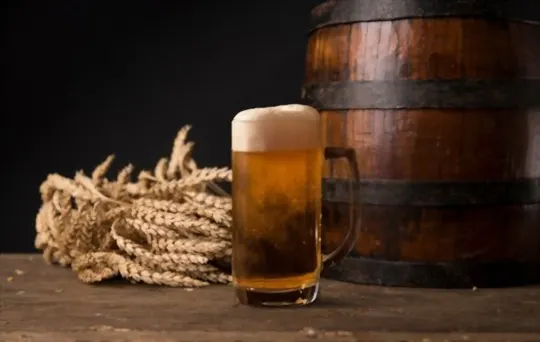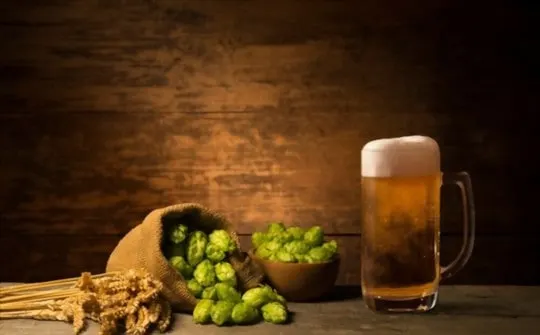Barley wine and beer sit at the adults’ table, each with a personality louder than the last family gathering. Barley wine isn’t actually wine. That’s right, it fools us with its name.
It’s beer’s fancy cousin with more alcohol and a bigger personality. We’ve all been there, thinking a quiet night with a beer, then barley wine shows up, and it’s a whole different party.
Beer, on the other hand, is the reliable friend we all love. You know what you’re getting: a good time, without the drama or the heavy head the next morning.
We’ve gone through bottles and cans, tasted and tested, so you get the scoop straight from the horse’s mouth. No fluff, just the good stuff.

What is Barley Wine?

Barley Wine is a strong ale that originated in England.
It typically has a higher alcohol content than regular beer and is made with more hops and malt.
This style of beer is often aged for several months or even years, which gives it a complex flavor profile.
Barley Wine has become increasingly popular among craft beer enthusiasts due to its unique taste and historical significance.
In terms of taste, Barley Wine is quite different from regular beer.
It has a sweeter, more malty flavor and tends to be much more full-bodied than traditional beers.
Additionally, the high alcohol content means that it can have a warming effect on the body when consumed.
One interesting detail about Barley Wine is that it was originally produced for export to Russia in the 18th century.
The high alcohol content was necessary in order to ensure that the beer would survive the long journey across the sea without going bad.
Today, this strong ale has gained popularity around the world as an alternative to traditional beer.
Overall, whether one prefers Barley Wine or regular beer ultimately comes down to personal taste.
However, those who appreciate complex flavors and a higher alcohol content may find this particular style of beer to be a better option.
What is Beer?

Beer is a fermented alcoholic drink made by brewing grains, such as barley, yeast, and hops.
It is one of the oldest and most widely consumed alcoholic beverages in the world.
With its vast diversity in styles, colors, flavor profiles and alcohol content, beer has become a staple beverage for many cultures.
Beers can be classified into lagers and ales, based on their fermentation process.
Lagers are brewed with yeast that ferments at a lower temperature, leading to a cleaner taste and crisper body.
Ales use yeast that ferments at higher temperatures resulting in more complex flavors and aromas.
Differences Between Barley Wine and Beer

Barley wine and beer stand apart from each despite having similar ingredients.
Barley wine is a stronger brew, while beer has a more varied range of styles.
The main differences between the two lie in their alcohol content, color, taste, and strength.
Barley wines are made from malted barley and have an alcohol content exceeding 9%, while beers have a lower alcohol content but come in a wide variety of colors, from light to dark.
Barley wines tend to be sweeter, more complex and richer in taste than most types of beers but they are less carbonated.
Additionally, barley wines age better compared to beers due to their high alcohol content; they can last for several years if appropriately stored.
One of the unique traits of Barley Wine is its ability to develop after being bottled for years producing rich flavors as it does so naturally whereas beer requires additional fermentation when you want aged flavors.
Despite sharing some similarities with beer products such as ale and stout, barley wine stands out due to its high alcohol levels that make it warmer when consumed and provide a fuller flavor than that found in most types of normal beer variants.
Ingredients Used
When it comes to creating a unique and flavorful drink, the ingredients used play a significant role.
In the case of Barley Wine and Beer, there are some similarities but also differences in ingredients that make them stand out from each other.
Barley Wine typically uses a higher concentration of malted barley than beer, giving it a sweeter and stronger taste.
It also uses more hops than traditional beer, which leads to a bittersweet flavor profile.
Beer generally has fewer malts and hops, resulting in a lighter taste with a lower alcohol content.
Both beverages use yeast for fermentation, which gives them their carbonation.
Another difference between the two is that barley wine often includes adjuncts like molasses or honey to add extra sweetness and flavor.
However, beer sticks to using only natural fermentable sugars like barley or wheat.
It’s essential to note that both drinks can come in a wide range of styles based on the mixture of these ingredients.
The multiple variations allow for endless experimentation within the brewing process that results in distinct tastes and aromas.
Brewing Process
The process of creating the perfect brew involves several steps.
From selecting the right ingredients to ensuring proper fermentation, each step in the brewing process affects the final product’s taste and aroma.
Here is a six-step guide to brewing that perfect beverage:
- First, choose your grain and other natural ingredients.
- Malt or roast your grains to perfection.
- Add hops at specific temperatures for bitterness and flavor.
- Boil your mixture for an extended period of time.
- Ferment your brew with either yeast or bacteria.
- Age your beer until it reaches its full potential flavor profile.
It’s important to note that certain elements can significantly impact the quality of beer or barley wine.
For example, the water used in the brewing process plays a critical role in how your beverage tastes.
Additionally, carefully monitoring both temperature and timing can make all the difference between a high-grade brew and one that falls flat.
By following these steps and paying attention to critical details, you’ll be able to create an impressive barley wine or beer that will surpass anything commercially available.
Alcohol Content and Strength
With regards to alcoholic beverages, one of the most important factors to consider is their alcohol content and strength.
While comparing Barley Wine and Beer, it is evident that they differ in these aspects.
Barley Wine generally has a higher alcohol content ranging from 8-12% ABV(Alohol by volume), while beer has a relatively lower content of around 4-7% ABV.
This means that Barley Wine possesses a stronger punch than regular beer.
Moving on, it is important to note that the difference in alcohol content also affects their serving sizes.
Given the high ABV of Barley Wine, it is often served in volumes that are significantly smaller than those for beer.
Serving a regular pint-sized glass of Barley Wine with such high alcohol content can lead to over-consumption, which could result in more severe situations like intoxication or alcohol poisoning.
As for additional considerations when comparing these drinks, components like ingredients and age may play an essential role.
For example, while both drinks use barley as their primary ingredient, Barley Wine has higher malt and hops concentration making its production process more intricate than that of beer.
Furthermore, Barley wine also tends to be aged for longer periods than beer which changes its taste profile.
Flavor Profile and Complexity
Craft beer enthusiasts often debate the differences in flavor profile and complexity between barley wine and beer.
Barley wine has a higher alcohol content than traditional beer, making it stronger and more intense in taste.
Its rich malty sweetness is balanced with notes of fruit and sometimes even hops.
On the other hand, beer typically has a lower alcohol content and comes in a wider variety of flavors depending on the style.
From light and refreshing lagers to bold and bitter IPAs, there’s a beer for everyone’s taste preferences.
Overall, both options offer unique taste experiences, but barley wine offers a depth of flavor that sets it apart from traditional beer styles.
Serving and Drinking Recommendations
- To fully enjoy the flavors in barley wine, use a tulip glass and let it warm to room temperature.
- Unlike beer, barley wine should be sipped slowly and savored to fully appreciate its complex flavors.
- When pairing with food, opt for strong and flavorful dishes like cheese, meat or chocolate desserts.
- Barley wine is high in alcohol content so it’s important to drink responsibly and in moderation.
In addition, it’s worth noting that age can greatly affect the taste of barley wine.
While many craft beers are best enjoyed when fresh, barley wine can actually benefit from aging for several years.
This allows the flavors to blend together and develop new complexities over time.
However, not all barley wines will improve with age so it’s important to do your research before investing in a bottle.
Overall, whether you prefer beer or barley wine ultimately comes down to personal preference but both offer their own unique characteristics and complexity for drinkers to enjoy.
Similarities Between Barley Wine and Beer
Barley wine and beer have many similarities.
Both are alcoholic beverages made from fermented grains, typically barley, hops, and yeast.
They are also similar in taste and appearance.
While beer is carbonated, barley wine is not, making it stronger and more flavorful than beer.
Additionally, both drinks can be brewed to varying strengths and can be enjoyed as a standalone brew or with a meal.
However, they differ in their alcohol content; with barley wine often having higher levels of alcohol per volume than beer.
Popular Barley Wine and Beer Styles

Barley wine and beer each have a vast number of distinct and popular styles available.
From IPA to stout, sour beer, brown ale, pilsner, and more, the craft brewing industry has shown immense creativity in crafting unique tastes for each type.
As various flavors of beer grow increasingly popular in different countries and cultures worldwide, barley wine remains an intriguing option due to its higher alcohol content than beers with comparable styles like Belgians and Scottish ales.
In addition to mainstream options like pale ales and porters, there are lesser-known varieties out there that cater to specific taste buds.
These include American Barley Wine, Rye Beer, Belgian Quadrupel Ale, Russian Imperial Stout, Lambic Fruit Beers among various others brewed by many craft brewers.
Considerations for Choosing Between Barley Wine and Beer
When selecting between a bottle of Barley Wine or a cold sip of beer, several things come to mind.
The flavor profile, alcohol content and the occasion play a significant role in making the right choice.
Beyond these basic considerations, it is essential to understand other factors that differentiate each type of drink.
Barley Wine is an ale that has been aged for an extended period and can have up to 15 percent alcohol content.
This level of alcohol is significantly high when compared to regular beers.
Beer on the opposite spectrum contains lower amounts of alcohol and is suitable for casual drinking because it does not have a heavily hopped flavor like barley wine.
However, Barley Wine is an excellent option for a sophisticated palate as it offers complex flavors like dark caramel, vanilla and bourbon tones with hints of raisins and figs while beer generally provides simple flavors depending upon its type – lager, pilsner or IPA.
It’s also crucial to note that barley wine should always be taken sparingly due to its alcoholic potency.
Occasion and Preference
For a memorable and enjoyable drinking experience, selecting the right beverage is imperative.
The choice of drink will solely depend on the occasion and individual preferences.
When it comes to preference, some individuals might opt for beer as it offers a wide range of flavors that suit different tastes.
On the other hand, barley wine has a more complex flavor profile with notes of maltiness, caramel, or fruitiness similar to red wines.
This makes it ideal for individuals who prefer stronger and bolder flavors.
In terms of occasion, beer is perfect for casual events such as sports nights or barbecues.
Conversely, barley wine is usually reserved for special or formal occasions such as weddings or gala nights.
In addition to preference and occasion, it’s crucial to consider factors such as alcohol content and serving temperature.
Barley wine contains higher alcohol levels than beer hence should be consumed in smaller quantities.
Additionally, it’s best enjoyed slightly warmer than beer to allow the flavors to fully develop.
Overall, when choosing between barley wine and beer, consider individual preferences and the specific occasion.
Whether you’re enjoying a cold brew on a hot summer day or sipping on a hearty barley wine during winter nights by the fireplace—both options offer delightful experiences in their unique ways.
Food Pairings
Barley Wine and Beer are two popular alcoholic beverages with a vast variety of flavors.
When it comes to matching them with different food items, there are certain pairings that work exceptionally well.
The complex flavors and high alcohol content of Barley Wine make it perfect for meat dishes like roasted lamb, steak, or barbecue.
Its sweetness also pairs well with desserts like chocolate and caramel.
Beer, on the other hand, has a wider range of flavors and carbonation levels, making it a versatile option.
Light beers go well with salads and seafood while heavier beers complement spicy dishes and burgers.
While choosing between Barley Wine vs Beer for pairing with food, it is crucial to consider the flavor profile of both.
It also depends on personal preferences and the type of cuisine being served.
Ultimately, the key to a successful pairing lies in experimentation and finding what works best for your taste buds.
Availability and Accessibility
The accessibility of Barley Wine and Beer may vary depending on a few factors.
While both are commonly found in liquor stores, the availability of certain brands or varieties could be region-specific.
Furthermore, beer is more widely available in most bars and restaurants than Barley Wine due to its mainstream popularity.
When it comes to accessibility, beer seems to have an upper hand over Barley Wine.
This is mainly because most bars and restaurants tend to serve a wider range of beers from different breweries compared to a limited selection of Barley Wines.
However, if one were to look for specific Barley Wines, they might have to do some research or travel further across various regions.
In addition, depending on your location, you might find it easier or harder to access certain brands or varieties of either beverage.
For instance, some smaller craft breweries might only distribute their beers locally while some well-known brands like Guinness have global distribution networks.
Despite this difference in accessibility, it ultimately boils down to personal preferences and availability in one’s local area.
Conclusion
Comparing the two beverages – Barley Wine and Beer, it can be difficult to determine which one is a better option.
However, based on their alcohol content, flavor profile and serving style, Barley Wine seems to have the edge over Beer.
The high alcohol content and complex flavors of Barley Wine make it an ideal choice for sipping slowly after a meal.
On the other hand, Beer is more suited for casual drinking with friends due to its lower alcohol content and refreshing taste.
Overall, choosing between Barley Wine and Beer depends on personal preference and the occasion or setting in which it is being consumed.
While Barley Wine would be suitable for a formal gathering or after-dinner drink, Beer would be ideal for enjoying with friends or at a casual social event.

Leave a comment